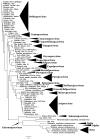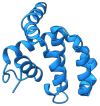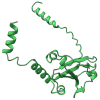The Role of Myxoma Virus Immune Modulators and Host Range Factors in Pathogenesis and Species Leaping
- PMID: 40872858
- PMCID: PMC12390650
- DOI: 10.3390/v17081145
The Role of Myxoma Virus Immune Modulators and Host Range Factors in Pathogenesis and Species Leaping
Abstract
Myxoma virus (MYXV) is a leporipoxvirus that causes lethal disease in Leporids. Hares and rabbits belong to the Leporidae family and are believed to have had a common ancestor 12 million years ago. After seventy years of contact with European hares without causing mortalities or disease manifestation, a recombinant MYXV infected Iberian hares (Lepus granatensis) causing high mortalities. Like all poxviruses, MYXV encodes a wealth of immune modulators required for successful virulence that also mediate host species jumping, for example, into hares. Here, we summarize the data of known MYXV immune modulators, their cellular functions, and their effects on European rabbits. Additionally, we suggest that the critical restrictions MYXV would encounter in colonizing a potentially new host species stem from their interactions with the host's innate immune environment. Lastly, we synthesize our understanding of some poxvirus genome architectural features that might have facilitated the host species jump of MYXV into hares from rabbits.
Keywords: host range; immune modulators; leporipoxvirus; myxoma virus; poxvirus; species leaping.
Conflict of interest statement
The authors declare no conflicts of interest.
Figures



























Similar articles
-
Genetic Characterization of a Recombinant Myxoma Virus in the Iberian Hare (Lepus granatensis).Viruses. 2019 Jun 7;11(6):530. doi: 10.3390/v11060530. Viruses. 2019. PMID: 31181645 Free PMC article.
-
Identification of a Novel Myxoma Virus C7-Like Host Range Factor That Enabled a Species Leap from Rabbits to Hares.mBio. 2022 Apr 26;13(2):e0346121. doi: 10.1128/mbio.03461-21. Epub 2022 Mar 30. mBio. 2022. PMID: 35352978 Free PMC article.
-
Epidemiological surveillance of myxoma virus in European hares (Lepus europaeus) in the Iberian Peninsula: First evidence of infection by the emerging ha-MYXV.Vet Microbiol. 2025 Mar;302:110405. doi: 10.1016/j.vetmic.2025.110405. Epub 2025 Jan 24. Vet Microbiol. 2025. PMID: 39892024
-
Rabbit hemorrhagic disease virus 2, 2010-2023: a review of global detections and affected species.J Vet Diagn Invest. 2024 Sep;36(5):617-637. doi: 10.1177/10406387241260281. Epub 2024 Jun 19. J Vet Diagn Invest. 2024. PMID: 39344909 Free PMC article. Review.
-
A rapid and systematic review of the clinical effectiveness and cost-effectiveness of paclitaxel, docetaxel, gemcitabine and vinorelbine in non-small-cell lung cancer.Health Technol Assess. 2001;5(32):1-195. doi: 10.3310/hta5320. Health Technol Assess. 2001. PMID: 12065068
References
Publication types
MeSH terms
Substances
Grants and funding
LinkOut - more resources
Full Text Sources

